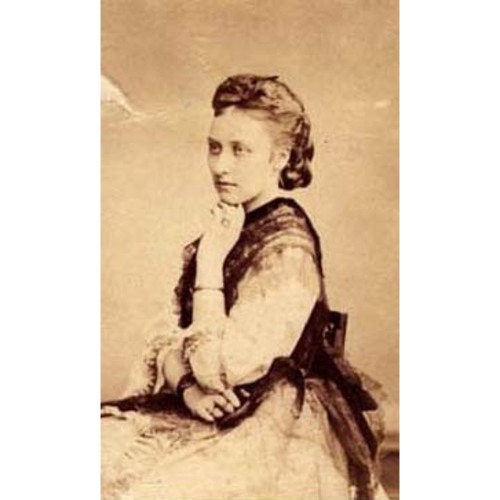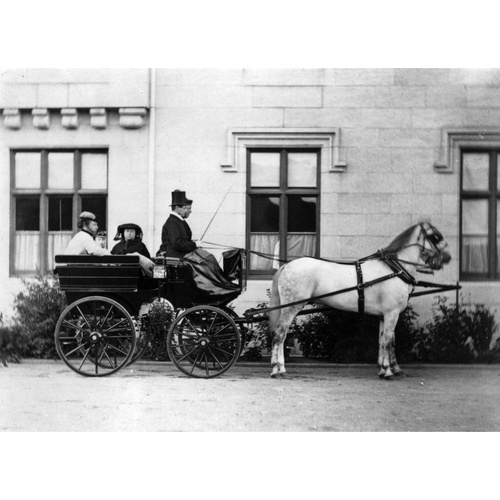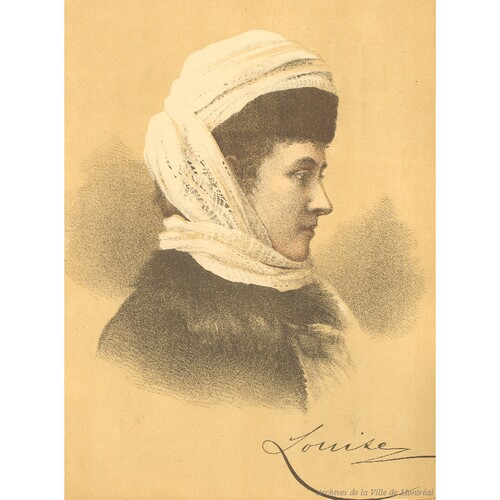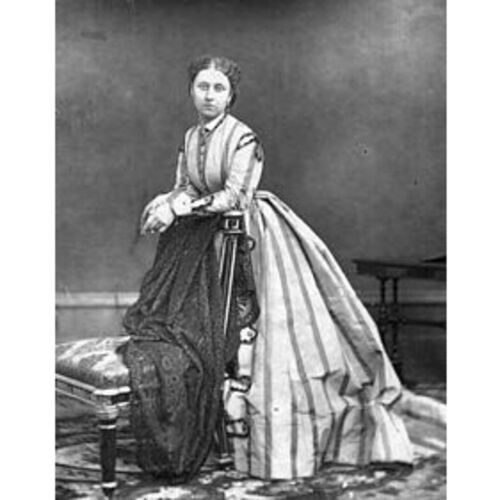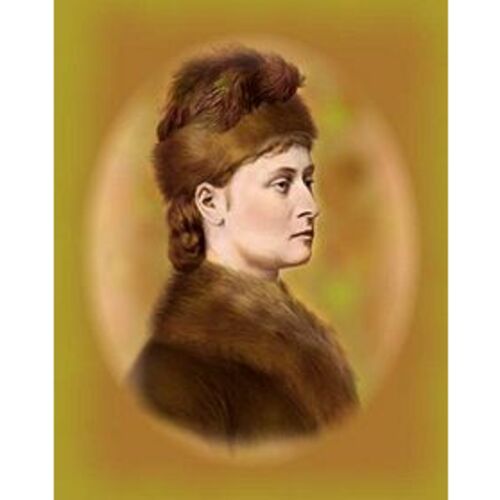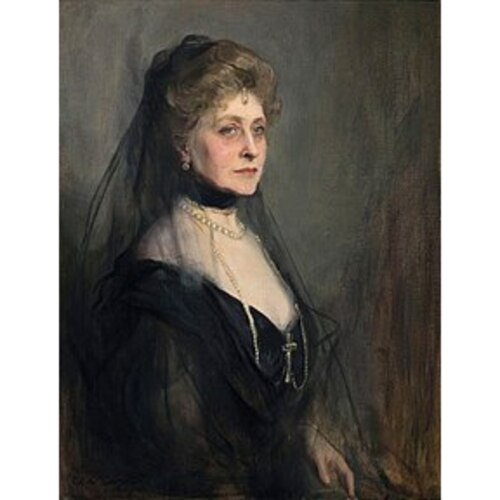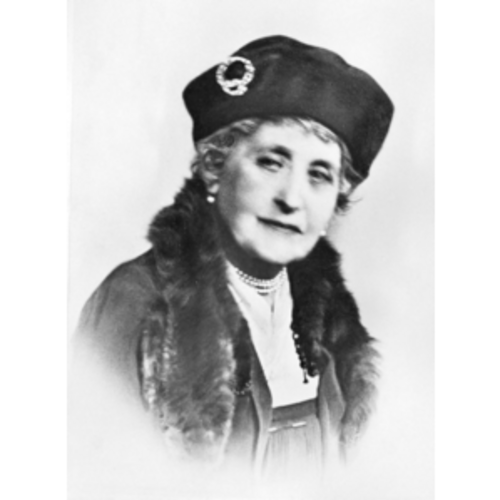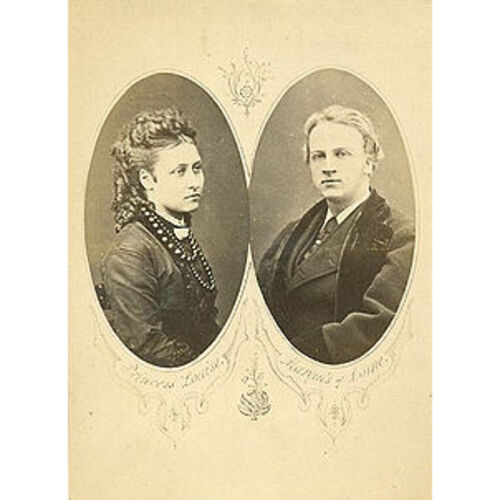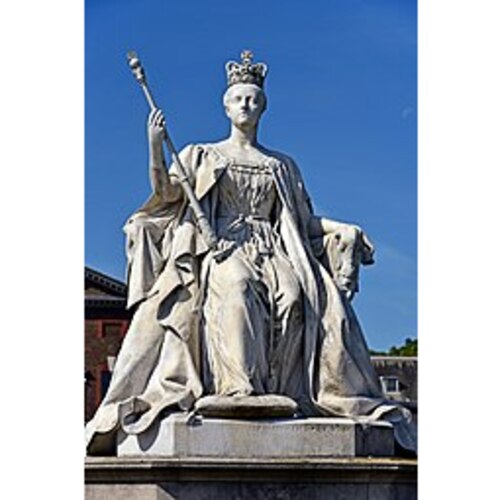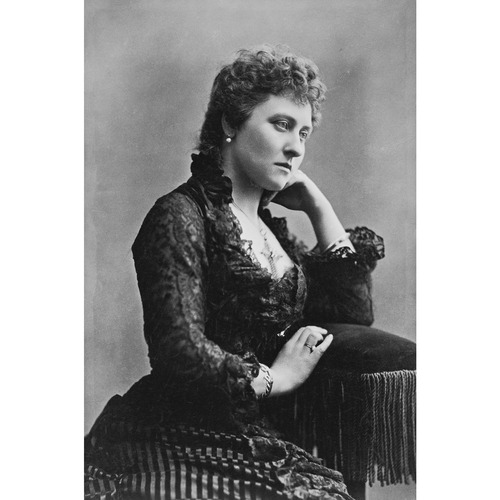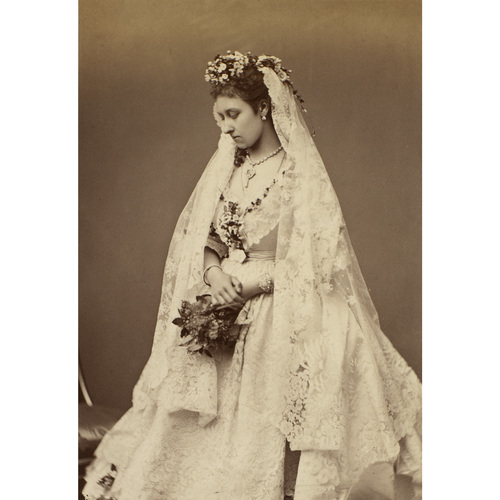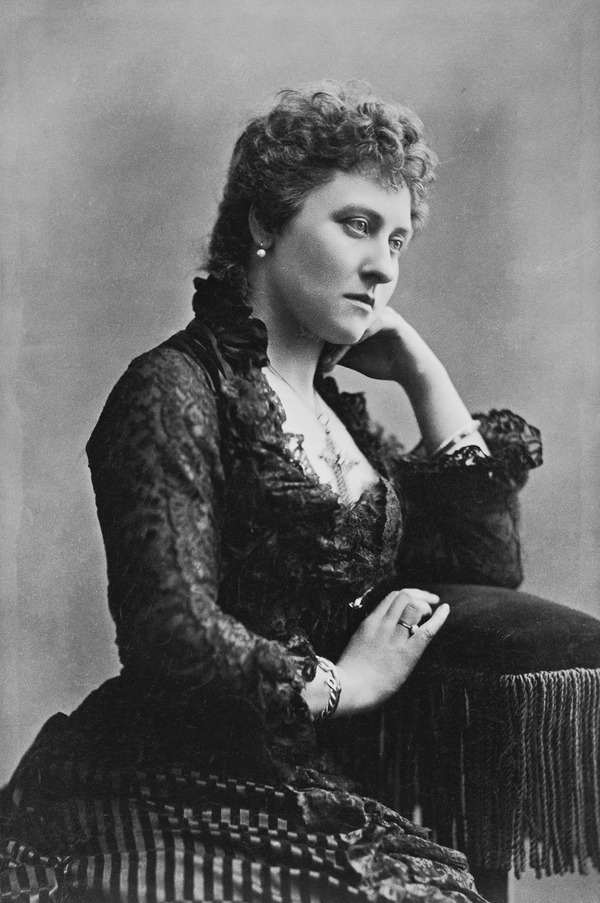
Source: Link
LOUISE CAROLINE ALBERTA (Campbell, Marchioness of LORNE, and Duchess of ARGYLL) (baptized Louisa Caroline Alberta), sculptor, personal secretary to Queen Victoria, viceregal consort, and painter; b. 18 March 1848 at Buckingham Palace, London, sixth of the nine children of Queen Victoria and Prince Albert; m. 21 March 1871 John George Edward Henry Douglas Sutherland Campbell*, Marquess of Lorne, at Windsor Castle, England; they had no children; d. 3 Dec. 1939 at Kensington Palace, London, and was buried at Frogmore, Windsor.
Princess Louise Caroline Alberta’s early tutelage in the palace schoolroom conformed to the rigorous system set by her father, and later in life she would lament “the habit of moulding all children to the same pattern.… It was deplorable. I know, because I suffered from it.” In addition to academic and religious instruction, she studied music and art, demonstrating a talent for sketching and painting inherited from her parents. Shy, naughty, and temperamental, she believed that, as a middle child, she was unnoticed and felt that she could never do anything right. When told of her father’s death, 13-year-old Louise cried out, “Oh, why did not God take me[?] I am so stupid and useless.” The queen’s prolonged mourning made Louise’s youth difficult.
The princess became interested in sculpture during her sittings with artists, and at age 15 she took lessons with sculptor Mary Thornycroft. At first her mother thought it an unsuitable pastime, but Louise’s skill was evident, and in 1868 she was allowed to enrol in the National Art Training School (later the Royal College of Art) in Kensington (London) – the first daughter of an English monarch to attend a school for commoners. Instructed by Joseph Edgar Boehm, she completed a marble bust of Victoria, which was exhibited at the Royal Academy in May 1869.
Opportunities to pursue her passion were limited: in 1866 she had become the social assistant to the queen, through which she gained knowledge of national affairs and patronage. She proved valuable, although less compliant than the two sisters who had preceded her in the role. She made known her opinions regarding two important political issues: Victoria’s seclusion and, later, women’s rights. Controversially, Louise supported the work of feminist Josephine Elizabeth Butler, whose efforts at social reform focused on the welfare of prostitutes. She was enthusiastic about equal academic opportunities and, in 1870, served as the first president of the Women’s Education Union, which advocated secondary education for girls. When in 1872 the Girls’ Public Day School Company was incorporated against considerable opposition, Princess Louise would become its patroness, raising funds to open its first school the following year.
Louise was considered to be the prettiest of Victoria’s five daughters and was much admired. She refused to be palmed off on a foreign prince and would not commit to a marriage without affection. In 1869 the queen began extending invitations to potential suitors, including the Marquess of Lorne. He and the princess fell in love, and in October 1870 they were engaged at Balmoral Castle, Scotland. The following March in St George’s Chapel, Windsor Castle, Louise became the first princess since 1515 to marry outside a European royal dynasty – and the first to wed a sitting member of parliament. The queen considered it “the most popular act of my reign.” The couple shared many interests and the union started well, although tensions would arise because of the anomaly of their social position and an unfulfilled yearning for children.
In 1878 Louise became the first female member of the royal family to visit North America when Lorne succeeded Lord Dufferin [Blackwood*] as the governor general of Canada. The couple landed at Halifax on 25 November to great fanfare. Although Louise learned on arrival that a young niece had just died, she carried on with her duties. Canadians gave the marquess and marchioness a tumultuous welcome at every stop on the journey to Ottawa. On 30 November Louise accepted the patronage of the Montreal Ladies’ Educational Association [see Anne Molson*]. Her reply was perhaps a reflection on her own upbringing: “The fruits of education are so attractive that we are often tempted to force them prematurely without sufficient tillage, and thus lose sight of the true objects of education, which consist much more in the development of intellect, than in the mere putting in of superficial knowledge, and of ‘cramming.’” Her serenity that day belied anxiety about the illness of her favourite sister, Alice Maud Mary, who would die on 14 December, the anniversary of their father’s passing.
Princess Louise busied herself with redecorating Rideau Hall, the governor general’s Ottawa residence, and setting up a studio. On the six-panel door of her parlour she painted a trompe l’oeil of blossoming crab-apple branches, which is still present. Sir Charles Tupper*, the minister of public works, accepted her proposal for enhancing some walls of the houses of parliament with a stencilled motif, and she oversaw the work to ensure completion before the opening of the new session in February 1879. Her role in supporting Lorne was tested during large entertainments, at which they were determined to avoid the appearance of a royal court. When their secretary issued instructions about specific evening dress for a particular occasion, the press accused them of being exclusionist: ordinary Canadians could not afford new gowns. The blunder was swiftly repaired, and the Lornes reputedly felt that “people [could] come as they like,” even “if they came in blankets!” At their first state ball Louise broke the Dufferins’ tradition of segregating the viceregal party for the quadrille of honour. She had not, however, taken into account the effects of copious champagne punch. A drunken senator kicked her train out of his way, and a cabinet minister, a chief justice, and a bishop were among those who had to be carried out.
Social gaucheries and homesickness did not prevent Louise from enjoying Canadian life. During their first winter she tobogganed, took ice-skating lessons alongside staff members, and hosted winter carnivals. Prime Minister Sir John A. Macdonald* would inform his British counterpart Benjamin Disraeli that “Louise is a great success in Canada, speaks to everybody and is interested in everything and skates divinely!” Following precedent, in June the couple moved into summer quarters at the Citadel in Quebec City, and while there they fell in love with the provincial capital. Louise laid a cornerstone at Kent Gate, named in honour of her grandfather, Edward* Augustus. Later that month she landed three salmon in one day during a fishing holiday on the Matapédia River, and her husband wrote to a friend in Scotland that she was well “able to rough it – sleeping in tents and in barges.” After a rewarding tour of the Maritime provinces, they were given a warm welcome in Toronto in September.
Having observed that appreciation of painting and architecture was not prominent in Canadian life, Louise had urged Lorne to establish a national collection to further art education. They revelled in the cultural attractions of Montreal, and while there in May 1879, Louise opened the rooms of the new Montreal Society of Decorative Art and became its first patroness. She also opened a gallery for the Art Association of Montreal, of which she was a member, and it was then that Lorne announced the foundation of the Canadian Academy of Arts. He and Louise composed the guidelines, calling for the design of “all sorts and kinds of useful things, from wearing apparel and embroidery to … new stoves and implements” and stressing the importance of exhibitions and competitions. From these acorns would grow the Royal Canadian Academy of Arts [see Lucius Richard O’Brien*; John William Hurrell Watts*] and the National Gallery of Canada [see Eric Brown].
Louise missed the academy’s opening the following March because of an accident in Ottawa on Valentine’s Day 1880, only 11 days after returning from three months’ leave in England. En route to a social event, the Lornes’ driver navigated a turn too quickly, and the sleigh hit a snow-bank and overturned. The horses bolted and the passengers were dragged several hundred feet; Louise was knocked unconscious for a moment and an earring tore through her earlobe. Afterwards, she suffered from the head injury, shattered nerves, and insomnia. The seriousness of her condition was kept from the press and the queen. That summer she made an appearance in Quebec City to unveil a coping stone at the Louise Embankment, but she soon sailed for England and was advised to stay there for the winter. Although battling pain and depression, she wanted to return to Canada for a viceregal tour of Manitoba in the summer of 1881, but Lorne and Louise’s physicians all believed that the journey would be too arduous. Because bulletins played down her ill health, the public suspected she was malingering and disliked Canada, an interpretation that has been adopted by some historians.
The next spring Louise felt stronger and left for Canada in late May. She was warmly welcomed after her long absence. Lorne was warned by the Home Office in London about a Fenian plot to kidnap the princess. He took it seriously: on 6 May his cousin Lord Frederick Charles Cavendish had been assassinated by revolutionary Irish nationalists in Dublin. As the couple prepared for an official visit to western Canada, security was increased for the train journey through the United States. In San Francisco their ship to Victoria was delayed because of a bomb scare, but officers found nothing. Despite the worry, Louise loved her three months in British Columbia and was heard to praise it as “halfway between Heaven and Balmoral.” Some in the province had been promoting secession [see George Anthony Walkem*]. Premier Robert Beaven*, realizing Louise’s popularity, was said to have suggested that if Vancouver Island became a separate kingdom she should be its queen. The entourage returned east through the southern states, well clear of the Fenian strongholds in the north. Lorne continued on to Ottawa, but Louise wintered in Bermuda for the sake of her health and safety. The press again criticized her absence and published stories about a row between her and Lady Macdonald [Bernard*]. Louise was so upset that she wrote to Sir John in early 1883 to assure him that she admired his wife and valued her friendship and kindness. The kindness was reciprocal: Louise had once recommended the services of her Swedish masseur in the hope that the therapy might help the Macdonalds’ disabled daughter, Margaret Mary Theodora.
When the princess returned to Ottawa in April, threats resurfaced. Shots were fired near Rideau Hall, after which officers were posted everywhere on the property. Tensions between the viceregal couple had been building, and when Lorne resigned his position early without consulting his wife, she was furious. Lorne had several reasons for this decision: among them was his feeling that “a new broom” would benefit the country, and he was concerned about Louise’s well-being. She never really forgave his disregard for her feelings. After their return to England in early November 1883, Louise had a nervous breakdown; ill health, combined with her childlessness and the death of her favourite brother, Leopold George Duncan Albert, left her depressed, and she was unhappy in her marriage. She lived apart from Lorne for a year. Unproven rumours resurfaced about Lorne’s homosexuality, and they lingered long after Louise had recovered. She and Lorne settled into a marriage of affectionate companionship. Louise turned to sculpture and immersed herself in philanthropic activities to give purpose to her life. Her youthful appearance, flirtatious behaviour, and wit provoked gossip, and new stories circulated in 1890 when her former instructor and supposed lover Boehm died of heart failure while she was in his studio. This inevitably led to speculation, unsubstantiated, about their relationship. She and Lorne, who became the 9th Duke of Argyll in 1900, had long since reconciled, and she would be devastated by his death in 1914.
From the 1870s onward Louise had exhibited her watercolours and sculpture alongside professional artists, but it was her serious interest in the latter that distinguished her. In 1887 she started on her best-known work, the marble statue depicting Queen Victoria at her coronation, which was unveiled in Kensington Gardens in June 1893. At that time it was the largest such monument completed by a female sculptor for a public place and was acclaimed by the Art Journal (London, August 1893) as “the most satisfactory of the many similar statues now in existence.” From this work she created a smaller bronze statue for the entrance to Royal Victoria College (now the Strathcona Music Building) at Montreal’s McGill University. In 1904 came another achievement: she was awarded an honorary lld from the University of Glasgow in recognition of her work to further the cause of women’s education, a project she had also pursued in Canada with, for instance, the Montreal Ladies’ Educational Association.
Princess Louise never forgot Canada. She had encouraged her friends Donald Alexander Smith* (later Lord Strathcona) and George Stephen* (later Lord Mount Stephen) to endow a scholarship so that Canadian students could attend the Royal College of Music in London, and in 1885 they created the Montreal Scholarship (which would become the Strathcona Scholarship in 1895). She also raised funds to send medical supplies to troops serving in the North-West rebellion [see Louis Riel*], stipulating that her contributions were to help “friend and foe” alike. She donated several paintings to the National Gallery of Canada. In 1905 a bronze sculpture she designed and executed was dedicated at St Paul’s Cathedral, London, to memorialize colonial soldiers who had fallen in the South African War – in particular, members of the Ottawa-based Princess Louise Dragoon Guards (redesignated the 5th Princess Louise Dragoon Guards in 1903 and the 4th in 1936). During the First World War she took a special interest in Canadian soldiers, housing the wounded at Kensington Palace, and in May 1916 she opened in Hyde Park the Daughters of the Empire Hospital for Canadian officers, which had been furnished by the Toronto businessman and philanthropist Albert Edward Gooderham* and his wife, Mary. That July she presented Canadian troops with a silver banner and shield for coming to the defence of Britain.
After a long widowhood Princess Louise, Duchess of Argyll, died at Kensington Palace on 3 Dec. 1939, aged 91. Unusually for royalty, she had requested cremation. Charles Vincent Massey*, the high commissioner to Britain, represented Canada at the funeral in St George’s Chapel on 12 December. Remembered by the Times (London, 4 Dec. 1939) as “the least bound by convention and etiquette of any of the Royal Family,” Princess Louise had achieved many firsts in her determination to escape the confines of her rank, setting a course that would be followed by members of subsequent generations of royalty. The Royal Canadian Academy of Arts and the National Gallery are her enduring contributions to Canadian life. As well, several places are connected with her: it was Louise who suggested the Latin word for “queen” for Saskatchewan’s capital and her third name, derived from her father’s, for the new province of Alberta, where Lake Louise [see Thomas Edmonds Wilson] and Mount Alberta were later christened in her honour. Her name remains associated with the Argyll and Sutherland Highlanders of Canada (Princess Louise’s), of which she was colonel-in-chief from 1905 until her death, and with the Princess Louise Fusiliers.
In addition to the sculpture mentioned in the biography, Princess Louise produced busts of her mother, other family members, and friends. The marble busts of her brothers Arthur William Patrick Albert*, Duke of Connaught and Strathearn, and Leopold George Duncan Albert, Duke of Albany, are in the Royal Coll. Trust, along with many of her sketches and watercolours: see Royal Coll. Trust, “Explore the collection,” Princess Louise, Duchess of Argyll (1848–1939): www.royalcollection.org.uk/collection/search#/page/1 (consulted 26 Feb. 2018). Her self-portrait bust in terracotta is in the collection of the National Portrait Gallery, London (NPG 4455). Another major work is the bronze reredos for the Battenberg Chapel in St Mildred’s Church in Whippingham, Isle of Wight, Eng.; Queen Victoria commissioned it to honour Prince Henry of Battenberg, the deceased husband of Louise’s youngest sister, Princess Beatrice Mary Victoria Feodore.
The National Gallery of Can. (Ottawa) holds 113 portraits and landscapes by Princess Louise, including graphite sketches and watercolours. Among them are views from Quebec City’s Citadel, of Niagara Falls and the Cascapédia and Fraser rivers, and of Government House, Victoria. In 1882 she arranged for G. D. Tomlinson’s painting The death of General Wolfe to be donated to the gallery.
Louise’s article on Quebec, containing verse by Lorne and her illustrations, appeared as “Quebec: pictures from my portfolio,” Good Words (London), 23 (1882), 217–25. She illustrated other works and articles under her name, H.R.H. Princess Louise.
Queen Victoria’s journal, the letters of Princess Louise, and other relevant correspondence are in the Royal Arch., Windsor, Eng. An invaluable private collection is held at Inveraray Castle (Scot.): the Marquess of Lorne and Argyll family papers, part of the Argyll papers (the family and estate archive of the Campbell family, earls and dukes of Argyll). LAC has copies of Lorne’s papers (R5321-0-1); also at LAC are the Sir John A. Macdonald papers (R14424-0-3), which contain letters concerning Princess Louise as well as extensive correspondence covering Lorne’s term as governor general and the couple’s years in Canada. The Dufferin papers at the Public Record Office of Northern Ireland, Belfast (D1071, D1231, and MIC22), are also useful for details about her time in Canada as well as her later life.
Beloved mama: private correspondence of Queen Victoria and the German Crown Princess, 1878–1885, ed. Roger Fulford (London, 1981). [J. G. E. H. D. S. Campbell] Duke of Argyll, Passages from the past (2v., London, 1907). J. E. Collins, Canada under the administration of Lord Lorne (Toronto, 1884). Darling child: private correspondence of Queen Victoria and the Crown Princess of Prussia, 1871–1878, ed. Roger Fulford (London, 1976). Darling Loosy: letters to Princess Louise, 1865–1939, ed. Elizabeth Longford (London, 1991). Dearest child: letters between Queen Victoria and the Princess Royal, 1858–1861, ed. Roger Fulford (London, 1965). Dearest mama: letters between Queen Victoria and the Crown Princess of Prussia, 1861–1864, ed. Roger Fulford (London, 1968). Matthew Dennison, The last princess: the devoted life of Queen Victoria’s youngest daughter (London, 2007). D. S. Duff, The life story of H.R.H. Princess Louise, Duchess of Argyll … with nineteen illustrations (London, 1940; repr. Bath, Eng., 1971). Sandra Gwyn, The private capital: ambition and love in the age of Macdonald and Laurier (Toronto, 1984). R. H. Hubbard, Rideau Hall: an illustrated history of Government House, Ottawa; Victorian and Edwardian times (Ottawa, 1967). Elizabeth Longford, Victoria R.I. (London, 1964). W. S. MacNutt, Days of Lorne: from the private papers of the Marquis of Lorne, 1878–1883, in the possession of the Duke of Argyll at Inveraray Castle, Scotland (Fredericton, 1955). ODNB. Records of the founding of the Royal Canadian Academy by His Excellency the Marquis of Lorne and Her Royal Highness the Princess Louise (Toronto, 1879–80). Michaela Reid, Ask Sir James (London and Toronto, 1987). Jane Roberts, Royal artists: from Mary Queen of Scots to the present day (London, 1987). R. W. Sandwell, “Dreaming of the princess: love, subversion, and the rituals of empire in British Columbia, 1882,” in Majesty in Canada: essays on the role of royalty, ed. C. M. Coates (Toronto, 2006), 44–67. Rebecca Sisler, Passionate spirits: a history of the Royal Canadian Academy of Arts, 1880–1980 (Toronto, 1980). R. M. Stamp, Royal rebels: Princess Louise & the Marquis of Lorne (Toronto and Oxford, 1988). Mark Stocker, Royalist and realist: the life and work of Sir Joseph Edgar Boehm (New York, 1988). Types of Canadian women …, ed. H. J. Morgan (Toronto, 1903). Jehanne Wake, Princess Louise: Queen Victoria’s unconventional daughter (London, 1988). Your dear letter: private correspondence of Queen Victoria and the Crown Princess of Prussia, 1865–1871, ed. Roger Fulford (London, 1971).
Cite This Article
Jehanne Wake, “LOUISE CAROLINE ALBERTA (Campbell, Marchioness of LORNE, Duchess of ARGYLL) (baptized Louisa Caroline Alberta),” in Dictionary of Canadian Biography, vol. 16, University of Toronto/Université Laval, 2003–, accessed January 10, 2026, https://www.biographi.ca/en/bio/louise_caroline_alberta_16E.html.
The citation above shows the format for footnotes and endnotes according to the Chicago manual of style (16th edition). Information to be used in other citation formats:
| Permalink: | https://www.biographi.ca/en/bio/louise_caroline_alberta_16E.html |
| Author of Article: | Jehanne Wake |
| Title of Article: | LOUISE CAROLINE ALBERTA (Campbell, Marchioness of LORNE, Duchess of ARGYLL) (baptized Louisa Caroline Alberta) |
| Publication Name: | Dictionary of Canadian Biography, vol. 16 |
| Publisher: | University of Toronto/Université Laval |
| Year of publication: | 2024 |
| Year of revision: | 2024 |
| Access Date: | January 10, 2026 |


